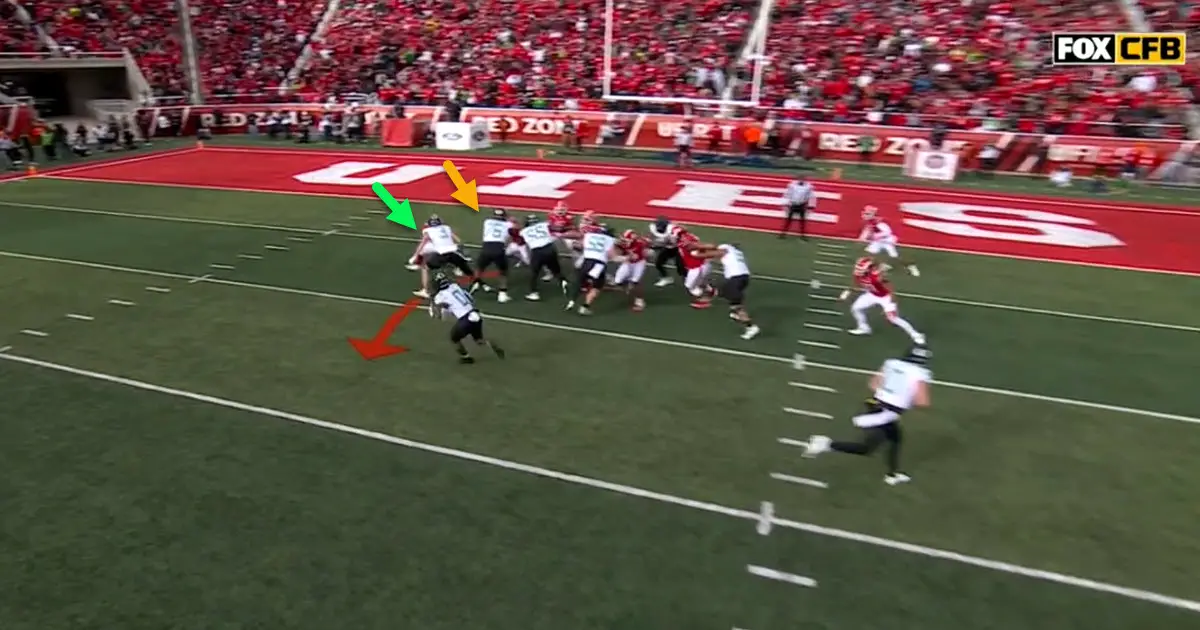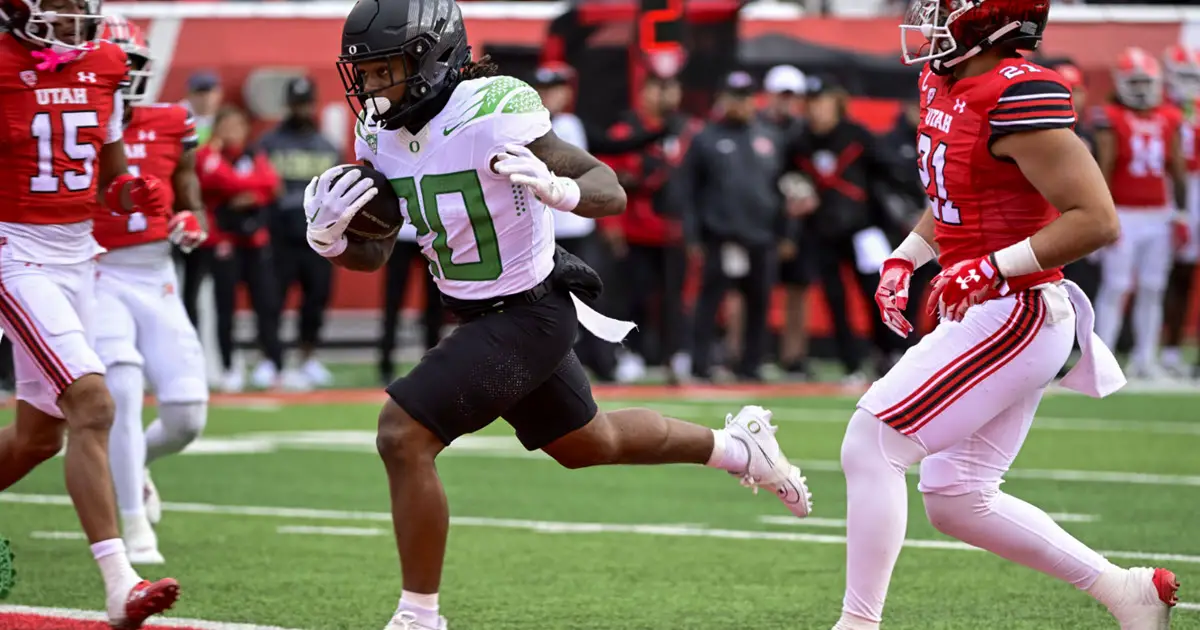I was surprised at some parts of the Oregon offensive game-plan versus Utah, as I did not anticipate these areas of Utah weakness that Offensive Coordinator Will Stein would attack. Often, coaches will attack from a schematic approach, or in terms of tempo, but I liked how OC Will Stein looked at matchups in the Utah game. He also noted tendencies in blitzing, and had a game plan created to exploit those Ute blitzes to make it easier for the Ducks to score. Let’s take a look…
First, I was amused to hear both Coach Kyle Whittingham and Coach Dan Lanning talk before the game about how the winner would be the team who dominated the trenches. While Oregon did well on the line of scrimmage on both sides of the ball, the ultimate difference were the strategies that Oregon employed to create easy plays to keep drives on-track. In my view, this game was not decided in the trenches, as that is something Mario Cristobal would say. Coach Lanning and Stein bring more to the table than that, as we are about to see.
You saw the opposite of the brute-force narrative in the first drive, as Oregon began the game for four straight pass plays before the running play (a counter) that took the Ducks down to the one-yard line. The Ducks were immediately showing the Utes that this was not a statement about our running game versus their rushing defense. This was about scoring, and Oregon loosened up the Utah defense in the very first drive with a variety of passes that were short, middle and deep as well on the boundaries along with in the middle zones.
There was no pattern to our passing attack, and it made Utah very aware that they could not just run-blitz the gaps with impunity. This initial drive was the key to the game in my view, as it surprised Utah and made them a bit more hesitant about their focus on stopping the run. Oregon was not going to employ the usual “establish-the-run-then-play-action-pass,” and this threw the Utes off their defensive game-plan. I’m sure the scouting report on Oregon is, “stop the Irving-James running game,” and it’ll get easier.
Nope!

Josh Conerly Jr. (Yellow arrow) sets the edge block, while Terrance Ferguson (Green arrow) stops the safety from perimeter contain, to score. (Fox Sports Video)
Oregon did not get the usual 200 yards rushing this game, (142 yards) but that was because of the balance of the offense established in that first drive. The Ducks rushed the ball 27 times for a pleasing average of 5.3 yards per carry versus that extraordinary Utah rush defense, while the Oregon passed the ball more times (31) to achieve an offensive balance that was hard for Utah to anticipate. Did you know what plays were coming? I sure did not, as the days of being predictable on offense are behind us.
A matchup that was critical to offensive success, was between No. 76 Josh Conerly Jr. at left tackle versus the leading sack leader in the nation in Jonah Ellis, No. 83 of Utah. The passing attack needed for balance hinged upon Conerly coming through, as his performance that day was All-American. Did you ever hear Ellis’s name mentioned? No, as Josh shut him down, and nobody is discussing this impactful matchup that was critical for Oregon’s offensive success.
Another astonishing “tell” that I noticed in studying the game later was how Ellis was very intent on getting into the backfield to the detriment of breaking contain as the force defender. After four straight passes in the first drive–guess who lost contain to a fantastic block by Josh Conerly? Mr. Ellis was easily run past on the left side, and this was a pattern that popped up on the significant plays later in the game. Oregon’s scouting detected this tendency, and took advantage of it in the Duck running game. Whew!
There were a number of pass plays that were so open in the middle of the field, and I had to go back and try to figure out why. The reason was because the Utah linebackers were blitzing, and Oregon was catching them in it before they could get to Bo Nix. But how did Oregon know?

Bo Nix somehow knew Utah was blitzing, and who was coming, thus the audible to the open middle. (Fox Sports Video)
Use the image above to help you track the video below to see it materialize as it did for me. Let’s first look at what is occurring and then hypothesize the “how” in a minute.
Look at the play, and then run it back and follow each of the Utah players indicated with the arrows in the image above the video. The pink arrow points to safety who has responsibility for covering the tight end, No. 88 Patrick Herbert. The red arrow points to an inside linebacker of Utah who is blitzing, and once he does–the middle zone is wide open. The yellow arrow points an outside linebacker who is lost–not knowing if he should be covering the middle or the zone he currents resides in.
Oregon receiver, Tez Johnson, No. 15 on the extreme right will cut inside the open area and Nix hits him quickly for 13 yards and an easy first down. As the replay is ending–Oregon does a fast tempo, and starts another play which results in another first down with Patrick Herbert breaking from a bunch formation and getting to the open middle–again. Now let’s look at a touchdown…

Superb play design and blitz recognition creates an Oregon touchdown. (Fox Sports Video)
Use this image above to help watch the video below.
The Utah linebacker with the yellow arrow will run to the flat as the play begins to cover anyone, usually a running back who may drift that direction. But he quickly realizes that the RB has already passed him by, and there is nothing he can do. The red arrow points to a safety who, at the snap runs out to cover the tight end, Terrance Ferguson, No. 3. The pink arrow points to a linebacker who is blitzing, and thus that is why the middle was so wide open for a touchdown!
How Did Oregon Know?
I am assuming that Oregon detected Utah blitz tendencies in down/distance situations, and when they lined up in a particular alignment–Bo would audible into the hot-read, or the play designed for this situation. I also believe that the injuries at linebacker created coverage hesitation at one position, hence disaster for the Utes when a fraction of a second in pass coverage is all that is needed to get open. Again, that is the matchups discussed earlier; Utah had an injury, and Oregon capitalized upon it.
I noted that the Utes liked to blitz often, and I believe that Oregon analyzed that even if the Utes were healthy–their linebackers were slow in pass coverage. As you know, Oregon has become quite skilled at throwing to the running back, and thus it was an attractive matchup for OBD.
Got a different perspective? Share it on the only free, civilized Oregon Message Board-forum because…
“Oh, how we love to ponder about Our Beloved Ducks!”
Charles Fischer (Mr. FishDuck)
Eugene, Oregon
Top Photo by Kiffer Creveling

Charles Fischer has been an intense fan of the Ducks, a season ticket holder at Autzen Stadium for 38 years and has written reports on football boards for over 26 years. Known as “FishDuck” on those boards, he is acknowledged for providing intense detail in his scrimmage reports, and in his Xs and Os play analyses. He is single, has a daughter Christine, and resides in Eugene Oregon where he was a Financial Advisor for 36 years.
He now focuses full-time on Charitable Planned Giving Workshops for churches and non-profit organizations in addition to managing his two Oregon Football Websites, of FishDuck.com and the Our Beloved Ducks forum. He is a busy man!
He does not profess to be a coach or analyst, but simply a “hack” that enjoys sharing what he has learned and invites others to correct or add to this body of Oregon Football! See More…

